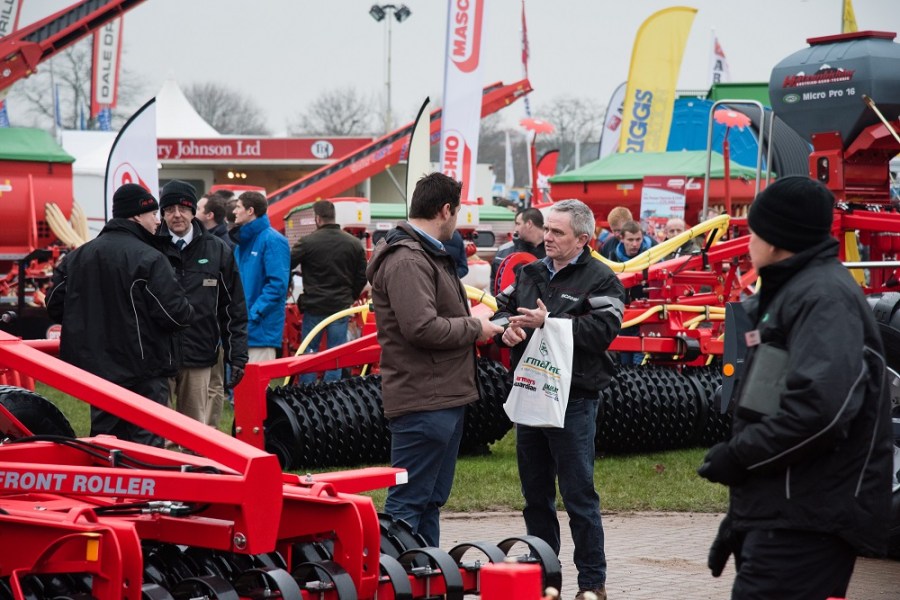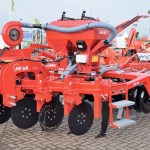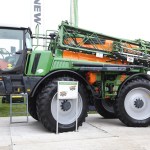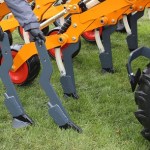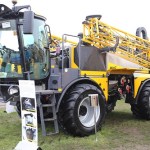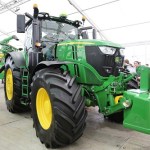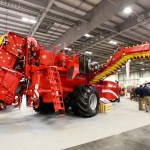Those who made the annual pilgrimage to Peterborough found machinery lines bristling with new models and technology seen for the first time in the UK. CPM picks out some of the gems.
The world’s biggest manufacturers were out in force.
By Jane Brooks
Traffic jams, fully booked hotels and a queue to get in, could only mean one thing: January’s outing to the LAMMA Show at Peterborough’s East of England Showground was underway.
With crowds of well over 40,000 people estimated to attend over the two days of the show, the world’s biggest manufacturers were out in force at the UK’s largest machinery show. Despite shivering on their stands in temperatures well below double figures, many of the 900 exhibitors reported it was a busy and successful event, according to organisers, while for many visitors, it’s almost become an annual pilgrimage.
- He-Va’s ultra-low disturbance subsoiler/seeding combination is designed specifically for cost-effective establishment of oilseed rape.
- The 2017 season Amazone Pantera self-propelled sprayer has had significant upgrades including an engine that now meets Stage IV final emission standards.
- Strip tillage specialists Mzuri introduced their low disturbance coulter system for the Pro-Til range.
- Chafer was showing its new hydrostatic self-propelled Interceptor sprayer, designed for medium to large-scale arable farms.
- John Deere’s R series tractors new flagship 6250R was a complete crowd puller with queues of people wanting to sit in the cab during entire two days of the show.
- Grimme used LAMMA to launch the latest addition to the Varitron Platinum range, the very first Varitron 220 Platinum self-propelled harvester.
Tractors to the fore
The Agricultural Engineers Association recently reported that 10,602 new agricultural tractors (over 50hp) were registered in 2016. This is 2.2% fall in numbers since 2015. As a single month, Dec showed a fall of 13.4% to 515 units.
While this is the lowest annual unit total for over a decade, during the second half of the year, sales did improve, after a first half that saw registrations record a year-on-year drop of 9.8%. Interestingly the average size of a unit continues to increase with a 0.8% rise last year to 158.3hp.
Massey Ferguson’s 6700S Series tractors featured on the MF stand show. The flagship MF6718S, a four-cylinder powerhouse, was the one everyone wanted to see. Rated at 175hp, with engine power management it’s boosted to 200hp at 2000rpm.
All six models in the range have the latest tier 4 final Agco Power 4.9 litre, four-cylinder engine. The MF 67118S has a 2.67m wheelbase and a turning radius of just 4.75m.
McCormick launched its most powerful tractor ever built, the McCormick X8 VT Drive. Three models deliver power ratings of 264hp, 286hp and 310hp. In a punchy special-order bright yellow, the top-of-the-range 310hp McCormick X8.680 looked ready for anything.
Power comes via a dual turbo 6-cylinder 6.7 litre Betapower Fuel Efficiency Tier4 Final power unit, built to McCormick specifications by engine makers FPT. Key features include heavy-duty CVT transmission, electronically controlled hydraulics with 157-litre or 212-litre load-sensing pumps, with115-litres/min dedicated to steering and other ancillary systems.
John Deere’s R series tractors new flagship 6250R was a crowd puller with queues waiting for a sit in the cab. Tipping the scales at 9.3t, the 6250R delivers more power than any tractor in its weight class, along with a power density of 31kg/hp. Rated at 250hp, it’s intelligent power management (IPM) system boosts power to 300hp when required. The twin turbo John Deere 6.8-litre PowerTech PSS engine with DPF and SCR technology meets Tier 4 final emission standards.
The upgraded AutoPowr transmission delivers 100% mechanical power at 3.5km/h for heavy draft operations, 11km/h for light draft work, 22.5km/h for heavy transport and 47.2km/h for light transport duties. When reaching maximum road speed, rpm automatically drops to maintain 50km/h at 1630rpm and 40km/h at 1300rpm.
The tractors also feature an all-new CommandPRO joystick. Top speed can be reached with just one push, and 11 programmable buttons are available for the hitch, PTO, SCVs, AutoTrac controls etc. The functionality of CommandPRO allows the tractor to be controlled from top speed to zero with a simple push or pull of the joystick, and lower speeds from 0-2km/h can be achieved with the creeper control function. Both the joystick and pedals can be operated at the same time, and there’s no need for an external ISOBUS joystick as the driver can also operate the tractor and ISOBUS functions simultaneously.
Deutz Fahr was showing its new 5, 6 and 7 series tractors. The six models of the 6 series were possibly of the most interest to the British market. Deutz’ six-cylinder engines offer 156hp to 212hp, complete with newly designed front suspension and integrated front linkage. A completely new ZF six-speed powershift transmission, with either shift or full auto, added to the TTV transmission variants already available.
JCB Fastrac 8290 and 8330 models were pulling in a crowd of admirers. The JCB traditional four-wheel suspension lives on and there’s a family resemblance to the 4000 series, although there are styling differences. The new Command Plus cab puts the driver further forward leaving more space to the rear of the body.
Tier4 final Agco Sisu 8.4-litre six-cylinder engines put the flagship 8330’s power rating at 335hp (348hp under load). The Fastrac 8290 is no slouch either, developing 306hp.
Fully approved hydrostatic steering should improve low speed manoeuvring. There’s also a system to prevent power steering being lost if there’s a hydraulic or engine fault.
GPS-ready and with self-steering capabilities, the in-cab screen doesn’t support ISOBUS. Probably with controlled traffic farming in mind, a 3m wheel track is available.
Caterpillar had the new D range ag-spec telehandlers, replacements for the C range, on show. Grabbing the most attention was the TH408D, a step-up from the TH407C. It’s powered by a four-cylinder 125hp, 4.4 litre Caterpillar engine. The same engine is also an option at 145hp. Lift capacity is 4t and it has an 8m reach.
Claas had the new Lexion 600 combine on its stand. Features for the 2017 season include a tier 4 final Mercedes engine, new automatic crop-flow control which detects and avoids potential blockages by monitoring engine speed, the APS drum, impellor drum and straw chopper. It also has a new straw chopper that’s engaged from the cab with a wider diameter drum and increased spread width.
Also making an appearance was the Claas tripod-mounted mobile Field Base RTK transmitter. This’ll enable farmers and contractors to take their RTK signal with them, rather than rely on getting a signal from a fixed mast or 3rd party supplier.
Claas says the two-frequency GPS and GLONASS receiver is accurate to 2-3cm over 3-5km and ready to work in about three minutes. What’s more, it uses an open signal so it can be used with any RTK receiver, and there’s a 20-hour battery.
Shown for the first time in the UK, Case IH was displaying its new new Axial-Flow Xtra-Chopping package. The firm’s working with Canadian outfit Redekop to bring its MAV (Maximum Air Velocity) straw chopper design to the UK market. The new package creates a finer chop and more even spread of straw, says Case IH. Two years of trials have honed it for UK conditions.
Xtra-Chopping retains the existing integral two-speed Case IH Magna-Cut 120-blade chopper. This is used as a discharge beater to pre-chop residue and propel it into the hood-mounted Redekop MAV chopper. This features 12-blade paddle fans at each end of the chopper rotor which draw straw and the chaff through the chopper as it is ejected.
Almost two thirds of the blades’ rotation is within a shroud to maximise chop efficiency, while the airflow also helps to present the straw lengthways to the 96 reversible carbide-coated blades, mounted in eight rows on the rotor. This is said to aid straw breakdown.
New Holland launched its latest baling products at LAMMA, including the new BigBaler 1290 Plus. This is the company’s new flagship square baler, and features include IntelliCruise that automatically regulates tractor ground speed to maximise baling capacity and uniform bale density. SmartFill feed flow tells the operator which direction to drive over the swath for even bale formation.
There’s an 80 cm longer baler chamber, said to deliver up to 10% higher density. The BigBaler’s double knot system is designed to guarantee high bale density with lower knotting strain, reducing the risk of twine snapping even in hot conditions. A baling challenge in France last year saw the BigBaler turn out 1254 straw bales in 17 hours, claims New Holland.
Grimme launched the latest addition to the Varitron Platinum range, the very first Varitron 220 Platinum self-propelled harvester. Features include a new high torque six-cylinder 354hp Mercedes Benz engine, which runs at 1300 rpm during road travel and 1500 rpm during digging.
A new control desk is integrated into the driver’s seat, which Grimme says has been ergonomically designed for the complex demand of self-propelled potato and beet harvesters. Up to 77 different functions can be programmed into the armrest and via the joystick, rotary or touch keys to avoid searching on the terminal.
There are upgraded hydraulics and track tensioning via the machine hydraulics of the Varitron. Previously an external system was required but now by switching the ball valve the tensioning is activated from the cab. New profiled carrier rollers, designed by Grimme, in the rubber track ensure smooth running under strong conditions without blockages.
Sprayers out in force
British sprayer manufacturer Chafer, based near Gainsborough, Lincs, were showing their new hydrostatic self-propelled Interceptor sprayer.
Powered by a Deutz 215hp Tier 4 final engine, it has Bosch Rexroth CVT transmission. It’s designed for medium to large-scale arable farms, and 4000 or 5000-litre tanks and boom widths of 24m to 36m can be specified. It’s available with the option of Chafer’s fully automatic E-Plumbing system.
Kuhn Farm Machinery had their high-capacity trailed fertiliser the Axent 100.1 on display as well as the upgraded Deltis 2 mounted crop sprayer. Replacing the original Deltis range, it features a number of significant upgrades including new chassis design and a 1300-litre tank design.
New controls are available in two formats: the manually operated Manuset valve system or the electronically controlled Diluset+ system. It’s available with a range of steel and aluminium booms in widths ranging from 15-24 metres.
On the Amazone stand was the 2017 season Pantera self-propelled sprayer, with its six-cylinder 218hp Deutz engine now meeting Tier 4 final emission standards. It uses exhaust gas recirculation, selective catalytic reduction with AdBlue and a diesel particulate filter (DPF). A new 20-litre AdBlue tank sits beside the 230-litre diesel tank. Amazone say AdBlue consumption is approximately 2.5% of the fuel consumption.
Suction capacity is up 20%, to a maximum of 600 l/min. This should speed up headland filling and the suction port has moved into the storage compartment under the cab. A Pantera+ version is also available with 25% greater climbing ability.
Drill delights
LAMMA saw the launch of Claydon’s new 3m trailed Hybrid T3 drill. It has a typical daily output of 20ha, says the company, and is suitable for use behind a 150hp tractor. The drill is supported on the lower link arms and incorporates a 2455-litre hopper, which can be used for seed only or divided to provide a 50:50 split between seed and fertiliser.
Measuring 6.6m long and 2.5m high, the new model incorporates support wheels with 10.00/75-15.3 deep-cleated tyres that run on clean, dry, uncultivated ground to ensure an even seeding depth. With a transport width of 3m, the T3 has an unladen weight of 2650kg.
Claydon also offers a kit to enable customers who already own a 3m Hybrid M3 mounted drill to convert it to the new trailed specification.
The Horsch stand featured the company’s new mounted Maestro drill featuring pneumatic single-grain technology. Available in either 8-row with 70cm, 75cm and 80cm row spacing or 12-row configurations with 45cm or 50cm spacing, each row has a 70-litre seed hopper feeding its own seed metering device.
A 300kg coulter pressure, adjustable on the move from the screen in the cab, enables operation at around 12km/h. The metering system uses a metering disc with outwards facing open slots. An electronic brushless motor drives each unit and requires only one amp per row unit so standard tractor electrics can power even 12-row drills.
Strip-tillage specialists Mzuri introduced their low disturbance coulter system for the Pro-Til range. It’s available in single and dual row versions, which can be specified for new machines or retrofitted to older models.
Pro-Til drills feature a row of leading discs followed by a set of staggered legs. The auto-reset coulter legs are fitted with pneumatic press wheels, which reconsolidate the soil twice for maximum seed-to-soil contact. Mzuri also used Lamma to announce they’re now offering a 2-year warranty.
New Crimper Rollers
Opico unveiled its new He-Va Crimper Roller – a knife roller designed to roll, cut and bruise cover crops in front of a direct drill. Available as a 3m rigid, or 3m, 4m or 6m folding model, the machine has angled edges set at 140mm spacing to cut or bruise a cover crop every 140mm along its length.
It also uses a HE-VA front press frame, which becomes an extension of the front of the tractor when attached, meaning it’s ‘trailed’ rather than pushed.
He-Va was also displaying its ultra-low disturbance subsoiler/seeding combination, available in mounted and trailed formats from 3m to 7m. Designed specifically for cost-effective establishment of oilseed rape, the new rig’s headstock frame is designed to accommodate opening discs ahead of the legs.
New slimline tines slot into the regular leg carriers, which can be shifted across the box-section frame to vary tine spacing. Typically a 3m version will have seven legs to create a narrower than normal 43cm row spacing.
The new CropChop knife roller was showcased by Weaving Machinery, designed to bruise and crush plants, when drilling through dense cover crops and standing crop residues.
The CropChop consists of two 380mm rollers fitted with boron steel blades. A staggered configuration of the blades provides minimal movement of soil and weed seeds complementing direct drilling systems. The double row roller provides twice the chopping action, which Weaving says is particularly advantageous when used in dense, tall, thick and woody crops.
Making a connection
From 2017, John Deere 7R, 8R and 9R Series tractors will benefit from enhanced connectivity and integration into the John Deere FarmSight range of precision farming solutions.
The new StarFire 6000 satellite receiver features enhanced SF1 signal accuracy from 23 down to 15cmp; a new SF3 signal with 3cm path to path accuracy, in-season repeatability, faster signal acquisition and a one-year subscription; plus an updated RTK/mobile RTK option.
New Holland’s FR Forage Cruiser can now provide improved information on key crop parameters with the optional NIR On BoardTM advanced sensor. Crop moisture and nutrient levels, including crude protein, crude fat, starch, neutral detergent fibre (NDF), acid detergent fibre (ADF) and ash can now be measured with +/- 2% accuracy.
New gadgets, devices and instruments
Visitors to LAMMA saw some of the smallest tracking products in the world. Richard Taylor MD of Automatrics said “we’ve not attended LAMMA since 2013, it took three years to get full NFU Mutual approval, which has now finally been formalised.”
Professional criminals know how to defeat GPS only location trackers in seconds, but Automatrics say their UHF location technology ensures the company still recovers 98% of protected assets, even if they’re inside shipping containers.
Warrington-based Calibre control were showcasing some of the latest advancements in grain-testing technology. One item was the Perten Falling Number (FN)1000 for measuring alpha-amylase activity in flour and grain. There are functions for automatic water level control, automatic start/stop and a touch-screen interface. No calibration is required.
Calibre also had the Pertens new AM5800 on display. This is a portable manual moisture meter, which can analyse moisture level and specific weight in 20 seconds. Perten says the device enables farmers to check grain quality levels to laboratory standard straight from the field, in store and at the dryer.
Another interesting new devise was the Agricision onTrac combined GPS receiver and lightbar system. It’s operated via an iPad or iPhone, attaches to a tractor bonnet and has a lightbar in the eyeline of the driver, which is easy to see but doesn’t obstruct vision. Set up and controlled via a free app, GPS correction signals are obtained from any freely available satellite source and deliver 20cm pass-to-pass accuracy.

